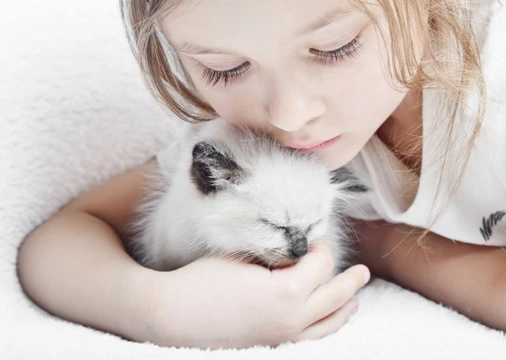
Cats and children - When to introduce them?
If you have children and also love cats but have not had a cat within the household since before your child was born, it can be hard for parents to decide if getting a cat for the family is the right decision.
There is a lot of merit to keeping pets with your kids from a young age, and early introductions can foster a lifelong love of and respect for pets of all types, as well as teaching important lessons about responsibility, safety and how to act around animals. However, it is also of course vital to ensure that your home environment is suitable for a cat, and that the cat will not find the experience of living with a child stressful or negative. There are many considerations to bear in mind where this is concerned, not least when to get a cat, how to introduce them to your child, and how to manage their relationship with each other. Ultimately, it is to be hoped that your child and the cat will become great friends, bond closely, and offer a lot of benefit and added value to each other’s lives.
If you are wondering if a cat would make a suitable addition to your family and if now is the time to get one, read on for some more information and advice on cats and children.
When should you get a cat?
One of the biggest questions for parents to consider is when to get a cat, in terms of the child’s age and life stage and willingness to accept the new addition! If your child is old enough to have already been in contact with cats and likes them, you have a head start, but if not, there are many other things to bear in mind. For very young children, it is unlikely that they will have developed any fear of or dislike of cats, so there is some merit to getting a cat while your child is very young, and will automatically see them as part of the family and grow up with them.
However, you must also bear in mind that the younger your child, the more time and attention they need, and the less time you will have to dedicate to taking care of your cat too.
If you wait until your child is older, they might already like the idea of having a pet, and may actively request a cat to join the family. If your child has not really met many cats, you should first try to take them visiting to friends who do have cats, and let your child get to know some cats and establish that they like them. It is a very poor idea to bring a cat into the household of an older child if the child is scared of or wary of cats without working on this first!
Adult cat or kitten?
Consideration number two, is whether you should get a kitten or an older cat. A kitten will be more amenable to settling into a new living situation and getting used to the presence of children when they are still young, and of course, is likely to have a longer remaining lifespan alongside of your child. But it is also important to remember that the younger the cat, the more care and attention they will need, and also, they will be rather more delicate and fragile than an older cat, which may not be a good match for a child who is only just beginning to learn how to behave around the cat!
An older cat, especially one that is already used to children, is less likely to be as playful as a kitten but will have the added advantage of size and maturity to withstand your child’s first forays into learning how to stroke and handle the cat!
Teaching your child and your cat about each other
Not only is it important to teach the child about correct behaviour around the cat, but you must also account for the fact that the cat is also likely to go through a very steep learning curve in regards to getting to grips with a small, loud and potentially boisterous human!
This is something that your cat will get to grips with in time, and picking a confident, bold cat that is not shy or nervous will make this process easier.
Teach your child that the cat is not a toy, and how to read the signals that the cat gives off in terms of when they want to be left alone. Make sure that your child never disturbs the cat when they are sleeping, knows how to stroke the cat, and does not play with or interfere with the cat’s food or water.
Also, allocate a room of the house that is out of bounds to the child but not the cat, to allow the cat a safe place to retreat to and snooze if they are finding the attentions of the child a bit too much!



